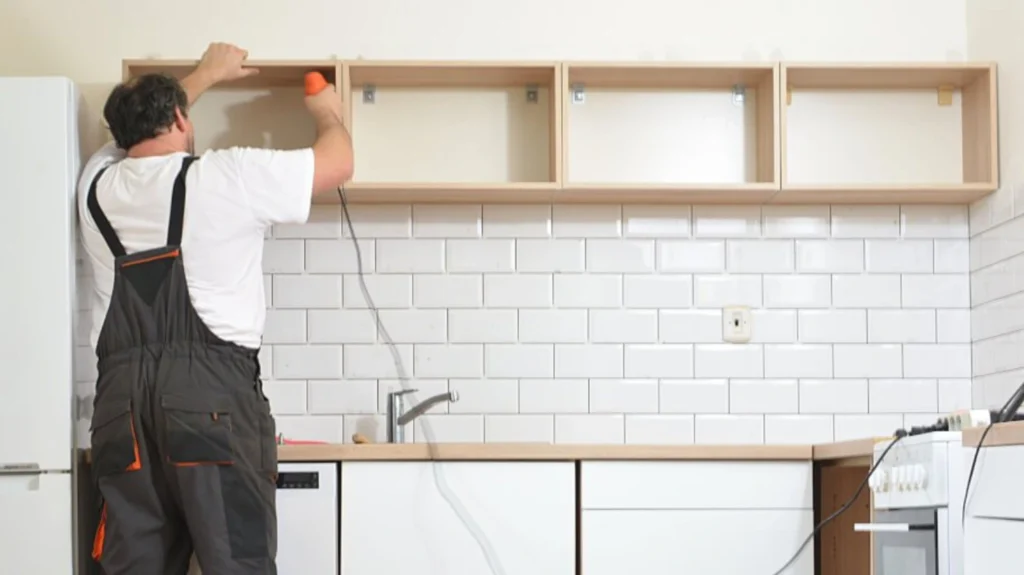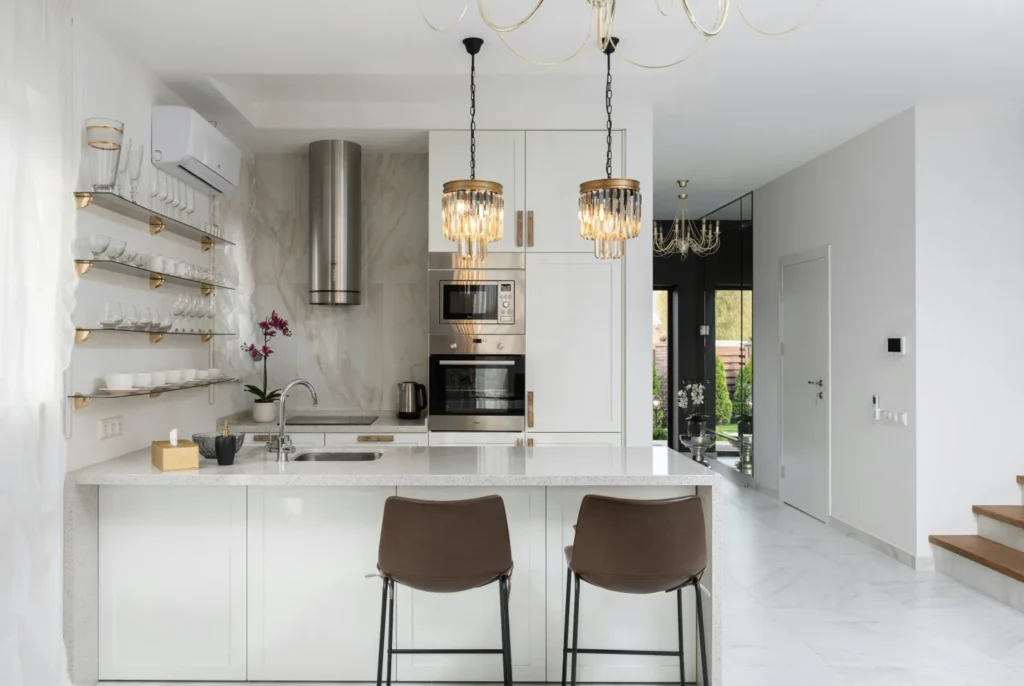Planning to install your own kitchen cabinets? With your cabinets ordered and your renovation underway, you might be considering a DIY installation instead of working with tradesmen. While it’s certainly a challenging task to DIY, it’s not impossible. With the right tools, careful preparation, and a solid strategy, installing kitchen cabinets can be managed perfectly.
Whether you’re planning to install your kitchen cabinets yourself or not, there are several key things that can help you through the process. From preparation to setting a proper timeline, this guide will walk you through everything involving kitchen cabinetry installation.
So let’s get started, shall we?
Is Installing Kitchen Cabinets Hard in Melbourne?
Is installing kitchen cabinets hard? No one has a definite answer. But one thing’s for sure: it’s easier said than done. As DIY cabinet installations get more popular by the day, many start wondering to themselves if they could save some money, too. And although it’s fully possible to do your own cabinet installation, you have to keep a few points in mind:

- Uneven Walls and Floors: Older homes in suburbs like Toorak and Camberwell always have uneven surfaces, which require blockers and wedges to level cabinets properly.
- Heavy Cabinets: Cabinets are heavy, and trying to install them alone isn’t a good idea. Lifting and holding cabinets while securing them can be physically hard and risky without help or the right support tools.
- Consistency Required: Have patience and consistency to achieve a great, perfect finish. Cabinets must be perfectly level and aligned to ensure that doors and drawers operate smoothly.
- Coordination with Other Trades: Plumbing, electrical, and tiling work need to be done carefully. Installing a couple of cabinets is one thing, handling the entire job is another.
So, to answer the question, “Is installing kitchen cabinets hard?” we must say that it could be. Especially if you think that you’re dealing with one or more of these complexities in your home, it’s best to leave installing kitchen cabinets in Australia to professionals like Silk Touch Joinery.
Our experienced installers know how to work with Melbourne’s unique homes, including those with uneven walls and floors, and ensure every cabinet is perfectly aligned and secure. We bring the right tools, skills, and precision to complete the job efficiently and make yours easier. So, don’t hesitate to contact us to get a quote!
Top 5 Tips for Installing Kitchen Cabinets DIY
Still, if you decide that you’re a tradesman yourself and want to DIY your kitchen cabinet installation, you should consider a few things first. If you want smooth sailing while installing your kitchen cabinets DIY, here are some golden rules that can literally save you time, resources, and honestly, brain cells.
1. Don’t Skip the Stud Finder
You’d be surprised at the number of people who just start drilling into drywall without checking for studs. As mentioned above, cabinets are heavy, and as disappointing as it may sound, screwing them into random spots won’t cut it. Use a stud finder, mark your studs properly, and double-check before lifting anything.
2. Label Every Cabinet Before You Start
Although this process might appear soul-sucking (and honestly it’s not that much better in real life), it’ll save your sanity. Before cabinetry installation, label each cabinet according to its position in the layout (like “Upper Left Corner” or “Sink Base”). That way, you’re not scrambling to figure out which box goes where mid-install. Especially helpful if you’re dealing with flat-packs or a big kitchen.
3. Get a Ledger Board, Seriously
Trying to hold a cabinet up with one hand while drilling with the other is as possible as you could imagine. A simple ledger board screwed into the wall gives you a “shelf” to rest cabinets on while you secure them. It’s a game-changer for solo installers.
4. Level Isn’t Optional
Let’s get this as simple as possible. If you’re eyeballing it, you’re doing it wrong. Use a long level and shims as needed. Even a few millimetres off can turn your sleek new kitchen into a wonky mess, especially when you’re trying to align doors and drawers later.
5. Have Extra Hands (or Clamps) Ready
Cabinet installation isn’t a one-person job unless you’re part octopus. Get a friend to help or invest in some cabinet clamps or a jack. The more stable your setup, the cleaner your install, and the fewer things you’ll end up yelling at.
How to Prepare for Your Kitchen Cabinet Installation?
Before setting a timeline for your kitchen cabinet installation, there are some things you should handle, no matter if you’re hiring professionals or doing it yourself. Preparing your kitchen for the process can help reduce stress and avoid unnecessary delays.
Here is what needs to be done before installing kitchen cabinets:

Prepare Floors and Walls: Before installing kitchen wall cabinets, make sure the floors are clean and the walls are ready for hanging cabinets. Cabinets should be installed on subflooring, not directly on finished floors.
Complete Plumbing and Electrical Work: Finish all related work before cabinet installation to avoid rework or damage.
Double-Check Measurements: Measure several times to make sure you have the correct data. This can prevent fitting issues.
Plan to Be Out of the Kitchen: Installation can be dusty and noisy. If you are not doing a DIY installation, make sure to stay out of the kitchen unless you are needed. Keep in mind to prepare meals and activities outside the home during the work.
Here is what needs to be done before installing kitchen cabinets:
- Prepare Floors and Walls: Before installing kitchen wall cabinets make sure the floors are clean and the walls are ready for hanging cabinets. Cabinets should be installed on subflooring, not directly on finished floors.
- Complete Plumbing and Electrical Work: Finish all related work before cabinet installation to avoid rework or damage.
- Double-Check Measurements: Measure several times to make sure you have the correct data. This can prevent fitting issues.
- Plan to Be Out of the Kitchen: Installation can be dusty and noisy, if you are not doing a DIY, make sure to stay out of the kitchen unless you are needed. Keep in mind to prepare meals and activities outside the home during the work.
Timeline for Installing Kitchen Cabinets
Understanding the timeline for installing kitchen cabinets can give you a big head start. It helps you set realistic expectations and plan your kitchen renovation step by step. Starting the job one day without knowing when or where it will finish won’t help you complete your kitchen renovation smoothly.

Keep in mind that the total installation time is flexible (from just a day to several days) depending on your skill level and the size of your kitchen. The more skilled you are, the faster it goes. Doing it alone might take longer, especially when installing upper cabinets. Hanging those alone can lead to uneven cabinets, so be sure to get some help!
Here is a typical step-by-step timeline for installing kitchen cabinets:
- Preparation (4-6 hours): Clear the kitchen space, remove old cabinets, and prepare the walls and floors. This includes sweeping and vacuuming the floors to avoid dust affecting your new kitchen cabinets.
- Measurement and Layout (1-2 hours): Measurement is the most important part, so make sure to do it carefully. Mark stud locations and draw level lines for both base and upper cabinets. Correct measurements are crucial to avoid fitting problems later.
- Cabinet Preparation (4-8 hours or more): Collect and gather your ready-to-assemble cupboards or prepare your custom kitchen cabinets. This step will vary depending on the type of cabinets you’re using.
- Installing Upper Cabinets (4-8 hours): Install upper cabinets first to avoid damage. This approach helps you install your base cabinets easier.
- Base Cabinets (4-8 hours): Make sure to secure base cabinets properly to avoid having uneven cabinetry.
- Finishing Touches (1-2 hours): Put on the doors and drawers, attach handles, and add some trim to give your cabinets that perfect, finished touch.
Keep in mind that the total installation time is flexible—from just a day to several days—depending on your skill level and the size of your kitchen. The more skilled you are, the faster it goes. Doing it alone might take longer, especially when installing upper cabinets. Hanging those alone can lead to uneven cabinets, so be sure to get some help!
Cabinetry Installation Prerequisites
When installing kitchen cabinets, managing and setting timelines with electricians, plumbers, designers, and contractors comes first. This process helps ensure that all necessary work is completed before the actual cabinet installation begins.
For instance, all plumbing and electrical work should be finished in advance to avoid damaging your new cabinets later on. Professional installers often call clients the night before, and again about an hour before arrival, to confirm the schedule and help homeowners prepare for noise, dust, and temporary disruption.
Clear communication also helps manage expectations around costs. Some joinery companies separate cabinet prices from installation fees and keep clients informed about any changes along the way.
Installing New Kitchen Cabinets with Silk Touch Joinery
Is installing kitchen cabinets hard? Definitely not with the professionals and tradespeople. Keep in mind that things can be quite different when you’re not doing a DIY kitchen cabinet installation. In that case, clear communication with professionals and tradespeople is crucial to make sure the project runs smoothly.
A smooth kitchen cabinet installation depends on more than just good craftsmanship. It also requires smart coordination. That’s why Silk Touch Joinery takes responsibility for managing the entire process from start to finish, working directly with plumbers, electricians, tilers, and other trades to make sure everything is done in the right order and at the right time.
We communicate clearly with you and every team involved, ensuring timelines are met, disruptions are minimised, and your kitchen comes together without surprises or delays. It’s how we make the complex process of kitchen renovation feel simple and stress-free.
Conclusion
Installing kitchen cabinets in Melbourne’s suburbs doesn’t have to be hard if you understand the timeline, communicate well, and prepare your home properly. Whether you’re installing kitchen wall cabinets or adding LED strip lights under kitchen cabinets, good planning and clear communication with your installer will make your kitchen renovation smoother and more enjoyable. Keep in mind to prepare your kitchen before contacting tradesmen or starting your DIY.
Now, if you’re ready to get started with installing your new kitchen cabinets and you need some professional help, time to give Silk Touch Joinery a call and find out how much your cabinet installation in Melbourne costs.
FAQs
1. Is It Better to Install Upper Cabinets or Base Cabinets First?
It’s best to install upper cabinets before base cabinets because it makes the installation easier and prevents damage to the base cabinets during the process.
2. Do You Tile a Kitchen Wall Before Installing Cabinets?
Usually, tiling is done after installing cabinets so tiles run behind them for a cleaner look, but it depends on your backsplash and lighting plans.
3. Can Kitchen Cabinets Come Pre-assembled?
Yes, many manufacturers offer pre-assembled or ready-to-assemble cabinets that can be installed quickly without the need for construction. Of course, you can always get the flat-pack kitchen customisation from Silk Touch Joinery. Not only is it affordable yet high-quality, but it’s also easy to install.
